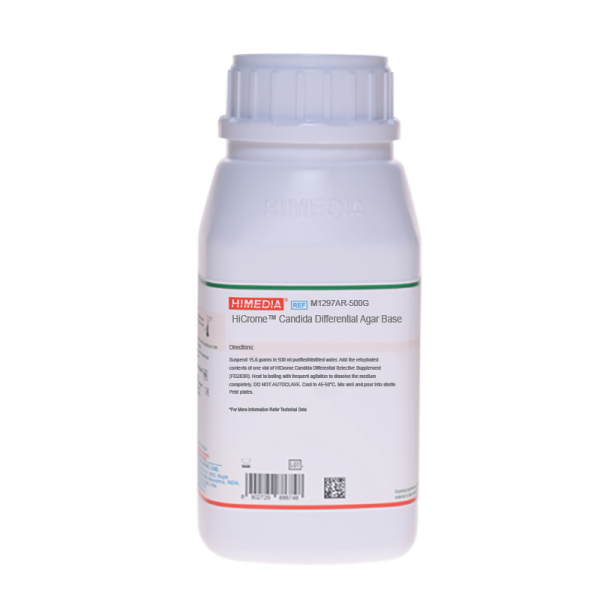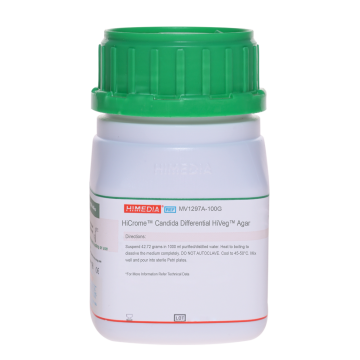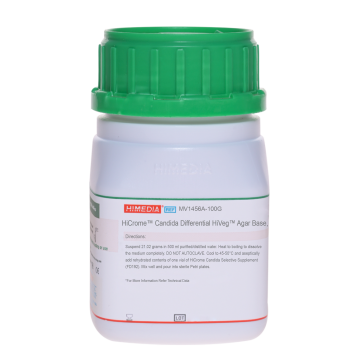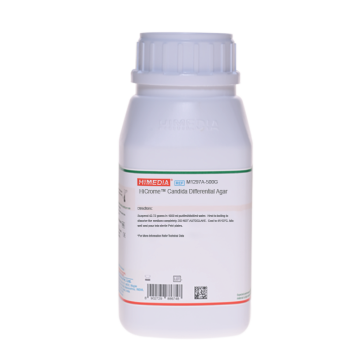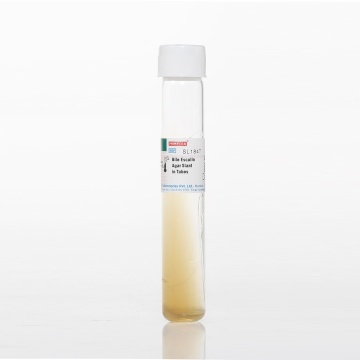 Your enquiry has been submitted
Your enquiry has been submitted
HiCrome™ Candida Differential Agar Base
Fungi -Yeasts and Molds#CC293D
Intended use
HiCrome™ Candida Differential Agar Base is selective and differential medium for rapid isolation and identification of Candida species from mixed cultures from clinical and non-clinical samples.
Composition
| Ingredients | g/L |
|---|---|
| Peptone | 4.000 |
| Chromogenic mixture | 13.600 |
| Agar | 13.600 |
Final pH (at 25°C): 6.0±0.2
**Formula adjusted, standardized to suit performance parameters
Directions
Suspend 15.6 gram in 500 ml purified / distilled water. Add the rehydrated contents of one vial of CH250 Selective Supplement (FD283R). Heat to boiling with frequent agitation to dissolve the medium completely. DO NOT AUTOCLAVE. Cool to 45-50°C. Mix well and pour into sterile Petri plates.
Principle And Interpretation
Perry and Miller (1) reported that Candida albicans produces an enzyme b-N-acetyl- galactosaminidase and according to Rousselle et al (2) incorporation of chromogenic or fluorogenic hexosaminidase substrates into the growth medium helps in identification of C. albicans isolates directly on primary isolation. HiCrome™ Candida Differential Agar Base incorporates two chromogens X-NAG which detects the activity of hexosaminidase and BCIP which detects phosphatase activity. HiCrome™ Candida Differential Agar Base is a selective and differential medium, which facilitates rapid isolation of yeasts from mixed cultures and allows differentiation of Candida species namely C.albicans, C.krusei, C.tropicalis and C.glabrata on the basis of colouration and colony morphology. On this medium results are obtained within 48 hours and it is useful for the rapid and presumptive identification of common yeasts in Mycology and Clinical Microbiology Laboratory. Peptone provides nitrogenous, carbonaceous compounds and other essential growth nutrients. Chloramphenicol from the supplement suppresses the accompanying bacterial flora. C.albicans appear as light green coloured smooth colonies, C.tropicalis appear as blue to metallic blue coloured raised colonies. C.glabrata, C.kefyr, C.parapsilosis colonies appear as cream to white, beige/yellow due to natural pigmentation and some alkaline phosphatase activity, while C.krusei appear as pink-purple, fuzzy, dry colonies.
Type of specimen
Clinical samples - skin scrapings, urine, Food & dairy samples
Specimen Collection and Handling:
For clinical samples follow appropriate techniques for handling specimens as per established guidelines (3,4).
For food and dairy samples, follow appropriate techniques for sample collection and processing as per guidelines (5,6). After use, contaminated materials must be sterilized by autoclaving before discarding.
Warning and Precautions :
In Vitro diagnostic Use. For professional use only. Read the label before opening the container. Wear protective gloves/protective clothing/eye protection/ face protection. Follow good microbiological lab practices while handling specimens and culture. Standard precautions as per established guidelines should be followed while handling clinical specimens. Safety guidelines may be referred in individual safety data sheets.
Limitations :
- Variations in colour intensity may be observed for Candida isolates depending on the presence of enzymes.
- Other Candida species may produce light mauve coloured colonies which is also produced by other yeast cells. This must be confirmed by further biochemical tests.
- Other filamentous fungi also exhibit colour on this medium.
Performance and evaluation
Performance of the medium is expected when used as per the direction on the label within the expiry period when stored at recommended temperature.
Quality Control
Appearance Cream to beige homogeneous free flowing powder
Gelling Firm, comparable with 1.36% Agar gel
Colour and Clarity of prepared medium Light amber coloured, opaque gel forms in Petri plates
Reaction Reaction of 3.12% w/v aqueous solution at 25°C. pH: 6.0±0.2
pH 5.80-6.20
Cultural Response
Cultural characteristics observed with added HiCrome Candida Differential Selective Supplement (FD283R) after an incubation at 30-35°C for 40-48 hours.
| Organism | Inoculum (CFU) | Growth | Recovery | Colour of Colony |
|---|---|---|---|---|
| Candida albicans ATCC 10231 (00054*) | 50-100 | good-luxuriant >=50% | light green | |
| Candida glabrata ATCC 15126 | 50-100 | good-luxuriant >=50% | cream to white | |
| #Teunomyces krusei ATCC 24408 | 50-100 | good-luxuriant >=50% | purple, fuzzy | |
| Candida tropicalis ATCC 750 | 50-100 | good-luxuriant >=50% | blue to purple | |
| Candida kefyr ATCC 66058 | 50-100 | good-luxuriant >=50% | cream to white with slight purple centre | |
| Candida utilis ATCC 9950 | 50-100 | good-luxuriant >=50% | pale pink to pinkish purple | |
| Candida parapsilosis ATCC 22019 | 50-100 | good-luxuriant >=50% | white to cream | |
| Candida membranifaciens ATCC 20137 | 50-100 | good-luxuriant >=50% | white to cream | |
| Candida dubliensis NCPF 3949 | 50-100 | good-luxuriant >=50% | pale green | |
| Escherichia coli ATCC 25922 (00013*) | >=104 | inhibited | 0% | |
| Staphylococcus aureus subsp aureus ATCC 25923 (00034*) | >=104 | inhibited | 0% |
Key: *Corresponding WDCM numbers. # - Formerly known as Candida krusei
Storage and Shelf Life
Store between 15-25°C in a tightly closed container and the prepared medium at 2-8°C. Use before expiry date on the label. On opening, product should be properly stored dry, after tightly capping the bottle in order to prevent lump formation due to the hygroscopic nature of the product. Improper storage of the product may lead to lump formation. Store in dry ventilated area protected from extremes of temperature and sources of ignition Seal the container tightly after use. Product performance is best if used within stated expiry period.
Disposal
User must ensure safe disposal by autoclaving and/or incineration of used or unusable preparations of this product. Follow established laboratory procedures in disposing of infectious materials and material that comes into contact with clinical sample must be decontaminated and disposed of in accordance with current laboratory techniques (3,4).
Reference
- Perry J. L. and Miller G. R., 1987, J. Clin. Microbiol., 25: 2424 -2425.
- Rousselle P., Freydiere A., Couillerot P., de Montclos H. and GilleY., 1994, J. Clin. Microbiol. 32:3034-3036.
- Isenberg, H.D. Clinical Microbiology Procedures Handbook 2nd Edition.
- Jorgensen, J.H., Pfaller, M.A., Carroll, K.C., Funke, G., Landry, M.L., Richter, S.S and Warnock., D.W. (2015) Manual of Clinical Microbiology, 11th Edition. Vol. 1.
- American Public Health Association, Standard Methods for the Examination of Dairy Products, 1978, 14th Ed., Washington D.C.
- Salfinger Y., and Tortorello M.L., 2015, Compendium of Methods for the Microbiological Examination of Foods, 5th Ed., American Public Health Association, Washington, D.C.
| Product Name | HiCrome™ Candida Differential Agar Base |
|---|---|
| SKU | M1297AR |
| Product Type | HiCrome™ |
| Physical Form | Powder |
| Origin | Animal |
| Packaging type | HDPE |
| References | 1. American Public Health Association, Standard Methods for the Examination of Dairy Products, 1978, 14th Ed., WashingtonD.C. |
| Customized Product Available | No |



